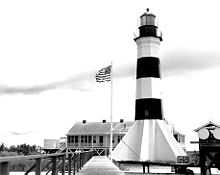Sabine Pass Light
 | |
| Sabine Pass Light | |
 | |
| Location | Cameron Parish, Louisiana |
|---|---|
| Coordinates | 29°42′59.5″N 93°51′0.6″W / 29.716528°N 93.850167°WCoordinates: 29°42′59.5″N 93°51′0.6″W / 29.716528°N 93.850167°W |
| Year first constructed | 1856 |
| Year first lit | 1856 |
| Deactivated | 1952 |
| Foundation | Brick buttresses / shellcrete |
| Construction | Brick |
| Tower shape | Octagon with eight buttresses |
| Markings / pattern | White with black stripe, "rocket ship" |
| Height | 75 feet (23 m) |
| Focal height | 85 feet (26 m) |
| Original lens | Third order Fresnel lens |
| Characteristic | Flashing white 90s |
|
Sabine Pass Lighthouse | |
| Nearest city | Cameron, Louisiana |
| Area | 2.4 acres (0.97 ha) |
| Architectural style | Greek Revival |
| Governing body | State |
| NRHP Reference # |
81000290 [3] |
| Added to NRHP | December 17, 1981 |
The Sabine Pass Light, or Sabine Pass Lighthouse, is a historic lighthouse on the Louisiana side of the Sabine River across from the community of Sabine Pass, Texas in Cameron Parish, Louisiana. It was first lit in 1857 and was deactivated by the Coast Guard in 1952. One of only three built in the United States of similar design, the light was listed on the National Register of Historic Places as "Sabine Pass Lighthouse" in 1981. It is presently abandoned but is the subject of preservation efforts.
History
On March 3, 1849, the United States Congress appropriated $7,500 for a lighthouse in Sabine Pass. Commander Henry A. Adams was sent to investigate a site location but reported, "“the coast is so free from danger in that vicinity, the place itself so easy of access, and the business done there so inconsiderable, that, in my opinion, a light-house is not necessary there at this time.” Construction was delayed until further calls for a light prompted a second appropriation in 1853.[4] Captain Danville Leadbetter (later to serve as a Confederate general), whose recommendation was instrumental in bringing about construction, also designed the station.[5]
Construction began in 1855 under the supervision of United States Lighthouse Service (LHS) inspector Walter H. Stevens (also later to serve as a Confederate States general) and took two years.[5] The tower was constructed of brick and was set on a shellcrete and wooden pile foundation.[5] The marshy location led to an unusual system of buttresses radiating from the base of the tower in order to stabilize it. The white painted tower was equipped with a third order Fresnel lens and lit for the first time in mid-1857.[4][2]
The beacon was extinguished during the Civil War in 1861, to hinder navigation by Union ships, but was returned to service December 23, 1865 after the Confederate surrender.[6] The tower was used as an observation post by both Confederate and Union soldiers, prompting a skirmish at the light on April 16, 1863 (five months before the Second Battle of Sabine Pass which was fought nearby) in which several men were killed.[4][5]
The original keeper's dwelling was destroyed by a hurricane in 1886, with the keeper and his wife surviving by holing up in the tower; a new dwelling and accessory buildings were constructed the following year. Another hurricane in 1915 shook the tower so violently that the clockwork for the beacon stopped, and the keeper rotated it by hand to keep the light active.[4] A daymark of two black bands was added in 1932.
In the early years of the twentieth century, jetties were constructed in the vicinity of the light, and by 1921 these extended well out into the gulf, necessitating their own navigational beacons.[4] This made the old light increasingly irrelevant, though it continued to be manned. In 1928 a radiobeacon was installed, and the following year the beacon was converted to electricity; the plumbing was upgraded in 1937.[5] A daymark of two black stripes was painted on the tower in 1932 following a suggestion from a Texaco tanker captain, who observed that the white structure was often hard to distinguish in the haze.[5] It was finally deactivated in 1952.[2] The remote location of the light made it vulnerable, and it suffered from vandalism and fires which destroyed the keeper's dwelling and outbuildings.[4] After years of being passed between various federal and state agencies, the surviving structure was sold at auction in 1985 to a pair of businessmen who had plans to build a marina or restaurant featuring the tower.[4] These plans were never realized, and in 2001 they donated it to the Cameron Preservation Alliance, which has constructed a road to the abandoned and decaying tower.[4][7] This preservation group has plans to make the 42 acre property into a parish historical museum.[2]
References
- ↑ "Historic Light Station Information and Photography: Louisiana". United States Coast Guard Historian's Office.
- ↑ 2.0 2.1 2.2 2.3 "Inventory of Historic Light Stations: Louisiana Lighthouses: Sabine Pass Light". National Park Service. Retrieved 10 January 2010.
- ↑ "National Register Information System". National Register of Historic Places. National Park Service. 2009-03-13.
- ↑ 4.0 4.1 4.2 4.3 4.4 4.5 4.6 4.7 "Sabine Pass, LA". LighthouseFriends. Retrieved 2013-04-23.
- ↑ 5.0 5.1 5.2 5.3 5.4 5.5 "Texas Lighthouse Series: Sabine Pass". Texas State Historical Association. Retrieved 2013-05-11.
- ↑ Lighthouse light extinguished- Retrieved 2013-05-03
- ↑ "Sabine Pass Lighthouse". Cameron Preservation Alliance. Retrieved 10 January 2010.
| ||||||||||||||||||||